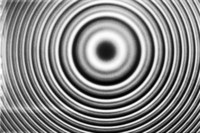
Photo from wikipedia
Graphene is emerging as a promising material for the integration in the most common Si platform, capable to convey some of its unique properties to fabricate novel photonic and optoelectronic… Click to show full abstract
Graphene is emerging as a promising material for the integration in the most common Si platform, capable to convey some of its unique properties to fabricate novel photonic and optoelectronic devices. For many real functions and devices however, graphene absorption is too low and must be enhanced. Among strategies, the use of an optical resonant cavity was recently proposed, and graphene absorption enhancement was demonstrated, both, by theoretical and experimental studies. This paper summarizes our recent progress in graphene absorption enhancement by means of Si/SiO2-based Fabry–Perot filters fabricated by radiofrequency sputtering. Simulations and experimental achievements carried out during more than two years of investigations are reported here, detailing the technical expedients that were necessary to increase the single layer CVD graphene absorption first to 39% and then up to 84%. Graphene absorption increased when an asymmetric Fabry–Perot filter was applied rather than a symmetric one, and a further absorption increase was obtained when graphene was embedded in a reflective rather than a transmissive Fabry–Perot filter. Moreover, the effect of the incident angle of the electromagnetic radiation and of the polarization of the light was investigated in the case of the optimized reflective Fabry–Perot filter. Experimental challenges and precautions to avoid evaporation or sputtering induced damage on the graphene layers are described as well, disclosing some experimental procedures that may help other researchers to embed graphene inside PVD grown materials with minimal alterations.
Journal Title: Materials
Year Published: 2022
Link to full text (if available)
Share on Social Media: Sign Up to like & get
recommendations!